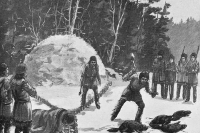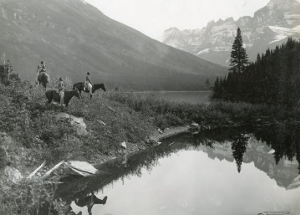The Making of the 50 States: Montana
Part 1: In the Beginning
Early European settlers came from France. As in North Dakota and South Dakota, Francois and Louis-Joseph Verendrye arrived in the early 1740s and claimed the area for their king, Louis XIV. In fact, it was France that sold the area to the United States, as part of the Louisiana Purchase in 1803. The Corps of Discovery led by Lewis and Clark traveled through the area twice–once in 1805, on the way to the Pacific Ocean, and once in 1806, on the way back to the East. About the same time, a number of land cessions by Native Americans paved the way for American settlers. In 1807, fur trader Manuel Lisa established the area's first fur trading post. 
More fur traders and more settlers followed, and farming became popular in the area. The American Fur Company built Fort Benton, on the Missouri River, in 1847. Major John Owen established Fort Owen in 1850. Fort Ellis and Fort Shaw came in later years. The rise of the cattle industry began in the 1850s and boomed in the 1860s. The discovery of gold in Grasshopper Creek in 1862 led to a settlement boom and the establishment of new towns like Bannack, Diamond City, and Virginia City (one end of the Bozeman Trail, which linked up with the Oregon Trail). Next page > The Rest of the Story > Page 1, 2
|
|
Social Studies for Kids
copyright 2002–2026
David White



 Among the Native American tribes living in what is now Montana before and after Europeans arrived were the Arapaho, Arikara, Assiniboine, Atsina, Bannock, Blackfeet, Cheyenne, Chippewa, Cree, Crow, Dakota, Gros Ventre, Hidatsa, Kalispel, Kiowa, Kootenai, Mandan, Nez Perce, Piegan, Salish, Sioux, Shoshoni, Spokan, and Tunahe. Preceding them were the Mississippian, Hopewell, and Woodland Cultures.
Among the Native American tribes living in what is now Montana before and after Europeans arrived were the Arapaho, Arikara, Assiniboine, Atsina, Bannock, Blackfeet, Cheyenne, Chippewa, Cree, Crow, Dakota, Gros Ventre, Hidatsa, Kalispel, Kiowa, Kootenai, Mandan, Nez Perce, Piegan, Salish, Sioux, Shoshoni, Spokan, and Tunahe. Preceding them were the Mississippian, Hopewell, and Woodland Cultures.
